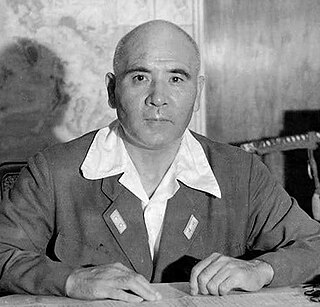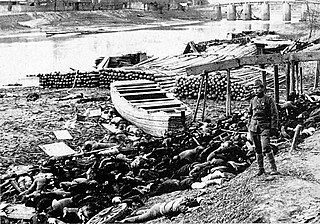
The Burma Railway, also known as the Siam–Burma Railway, Thai–Burma Railway and similar names, or as the Death Railway, is a 415 km (258 mi) railway between Ban Pong, Thailand, and Thanbyuzayat, Burma. It was built from 1940 to 1943 by South East Asian civilians abducted and forced to work by the Japanese and a smaller group of captured Allied soldiers, to supply troops and weapons in the Burma campaign of World War II. It completed the rail link between Bangkok, Thailand, and Rangoon, Burma. The name used by the Japanese Government was Tai–Men Rensetsu Tetsudō (泰緬連接鉄道), which means Thailand-Burma-Link-Railway.

The International Military Tribunal for the Far East (IMTFE), also known as the Tokyo Trial and the Tokyo War Crimes Tribunal, was a military trial convened on 29 April 1946 to try leaders of the Empire of Japan for their crimes against peace, conventional war crimes, and crimes against humanity, leading up to and during the Second World War. The IMTFE was modeled after the International Military Tribunal (IMT) at Nuremberg, Germany, which prosecuted the leaders of Nazi Germany for their war crimes, crimes against peace, and crimes against humanity.

Masaharu Homma was a lieutenant general in the Imperial Japanese Army during World War II. Homma commanded the Japanese 14th Army, which invaded the Philippines and perpetrated the Bataan Death March. After the war, Homma was convicted of war crimes relating to the actions of troops under his direct command and executed by firing squad on April 3, 1946.

Sugamo Prison was a prison in Tokyo, Japan. It was located in the district of Ikebukuro, which is now part of the Toshima ward of Tokyo, Japan.

Changi Prison Complex, often known simply as Changi Prison, is a prison complex in the namesake district of Changi in the eastern part of Singapore. It is the oldest and largest prison in the country, covering an area of about 50 ha. Opened in 1936, the prison has a rich history.

During its imperial era, the Empire of Japan committed numerous war crimes and crimes against humanity across various Asian-Pacific nations, notably during the Second Sino-Japanese and Pacific Wars. These incidents have been contentiously referred to as "the Asian Holocaust", and "Japan's Holocaust", and also as the "Rape of Asia". The crimes occurred during the early part of the Shōwa era, under Hirohito's reign.

Japan had an official slave system from the Yamato period until Toyotomi Hideyoshi abolished it in 1590. Afterwards, the Japanese government facilitated the use of "comfort women" as sex slaves from 1932 to 1945. Prisoners of war captured by Japanese imperial forces were also used as slaves during the same period.
Kawakita v. United States, 343 U.S. 717 (1952), is a United States Supreme Court case in which the Court ruled that a dual U.S./Japanese citizen could be convicted of treason against the United States for acts performed in Japan during World War II. Tomoya Kawakita, born in California to Japanese parents, was in Japan when the war broke out and stayed in Japan until the war was over. After returning to the United States, he was arrested and charged with treason for having abused American prisoners of war. Kawakita claimed he could not be found guilty of treason since he had lost his U.S. citizenship while in Japan, but this argument was rejected by the courts, which ruled that he had in fact retained his U.S. citizenship during the war. Originally sentenced to death, Kawakita's sentence was commuted to life imprisonment, and he was eventually released from prison, deported to Japan, and barred from ever returning to the United States.

Far East prisoners of war is a term used in the United Kingdom to describe former British and Commonwealth prisoners of war held in the Far East during the Second World War. The term is also used as the initialism FEPOW, or as the abbreviation Far East POWs.

Takuma Nishimura was a Japanese army general in the Imperial Japanese Army during World War II, active in the invasion and occupation of British Malaya. After the Japanese surrender, he was tried and convicted in British Singapore as a war criminal for his role in the Sook Ching massacres. After four years imprisonment he was handed to Australian authorities for trial on the Parit Sulong Massacre and executed by hanging by the then Australian Territory of Papua and New Guinea.

After World War II there were from 560,000 to 760,000 Japanese personnel in the Soviet Union and Mongolia interned to work in labor camps as POWs. Of them, it is estimated that between 60,000 and 347,000 died in captivity.

Ōryoku Maru was a Japanese passenger cargo ship which was commissioned by the Imperial Japanese Navy during World War II as a troop transport and prisoner of war (POW) transport ship. Japanese POW transport ships are often referred to as hell ships, due to their notoriously unpleasant conditions and the many deaths that occurred on board. In December 1944, the ship was bombed by American aircraft, killing 200 Allied POWs. Hundreds more died in the months that followed.

Ban Song Karia, also spelled Songkalia (ซองกาเลีย) and alternatively known as Songkurai, is a village in the Sangkhla Buri District of the Kanchanaburi Province, Thailand near the border with Myanmar at the Three Pagodas Pass. It was the location of three World War II Japanese Prisoner of War Camps located about 13 kilometres (8.1 mi) south of the Thai/Burma border.
John David Provoo was United States Army staff sergeant and practicing Buddhist who was convicted of treason for his conduct as a Japanese prisoner of war during World War II. His conviction was later overturned on a technicality, and he became a Buddhist priest.

The controversies surrounding Yasukuni Shrine are related to the choice of Japanese people to visit this Shinto shrine and war museum in central Tokyo. The shrine is based on State Shinto, as opposed to traditional Japanese Shinto, and has a close history with Statism in Shōwa Japan. Most of the dead served the Emperors of Japan during wars from 1867 to 1951 but they also include civilians in service and government officials. It is the belief of Shinto that Yasukuni enshrines the actual souls of the dead, known as kami in Japanese. The kami are honoured through liturgical texts and ritual incantations known as Norito.

The New Bilibid Prison (NBP) in Muntinlupa, Metro Manila is the main insular prison designed to house the prison population of the Philippines. It is maintained by the Bureau of Corrections (BuCor) under the Department of Justice (DOJ). As of October 2022, the NBP housed 29,204 inmates, nearly five times its intended capacity of 6,345.

The Leipzig war crimes trials were held in 1921 to try alleged German war criminals of the First World War before the German Reichsgericht in Leipzig, as part of the penalties imposed on the German government under the Treaty of Versailles. Twelve people were tried, and the proceedings were widely regarded at the time as a failure. In the longer term, they were seen by some as a significant step toward the introduction of a comprehensive system for the prosecution of international law violations.
Keiko Holmes (恵子・ホームズ) is a Japanese coordinator for a charity named Agape, which helps to promote reconciliation between Japan and her former World War II prisoners of war (POWs). She lectures at universities and schools, and was awarded the O.B.E.

The Palawan massacre occurred on 14 December 1944, during World War II, near the city of Puerto Princesa in the Philippine province of Palawan. Allied soldiers, imprisoned near the city, were killed by Imperial Japanese soldiers. Only eleven men managed to survive.
The Hanaoka mine was an open-pit mine with major deposits of “black ore”, located in the Tōhoku region of northern Japan in the village of Hanaoka, Kitaakita District, Akita Prefecture. The area is now part of the city of Ōdate.















